Speak directly to the analyst to clarify any post sales queries you may have.
The Fruit Tea Market is undergoing rapid transformation as evolving consumer preferences, sustainability initiatives, and advancements in product innovation reshape competitive dynamics for global stakeholders.
Market Snapshot: Fruit Tea Market Size and Growth Outlook
According to the latest research, the Fruit Tea Market grew from USD 2.90 billion in 2024 to USD 3.10 billion in 2025, with expectations for continued expansion at a 6.53% CAGR, projected to reach USD 4.82 billion by 2032. This growth trajectory underscores rising global demand for fruit tea driven by health-centric lifestyles, clean-label preferences, and sustainability concerns. Both established brands and emerging players are capitalizing on consumer migration toward functional beverages and diversified retail experiences.
Scope & Segmentation: Comprehensive Analysis of Product, Flavors, Packaging, Sweeteners, and Distribution
This report covers critical aspects of the fruit tea sector, equipping leaders with data for actionable decision-making and strategic alignment. Key coverage areas include:
- Product Types: Concentrates (frozen, liquid), powders (bulk, single-serve sachets), and ready-to-drink options (bottle, can, carton).
- Flavors: Berry (blueberry, strawberry), citrus (lemon, orange), and tropical (mango, pineapple) profiles accommodate regional and lifestyle demands.
- Packaging Types: Glass and PET bottles, cans, cartons (paperboard, Tetra Pak), and flexible pouches targeting portability and sustainability.
- Sweetener Types: Artificial sweeteners (aspartame, sucralose), honey, sugar, and no added sugar for diverse dietary needs.
- Distribution Channels: Convenience stores, online retail (direct-to-consumer, e-commerce), specialty stores, and supermarkets/hypermarkets catering to both impulse and planned purchases.
- Geographic Coverage: Americas (North America, Latin America), Europe, Middle East & Africa (EMEA), and Asia-Pacific; main countries include the United States, Canada, Brazil, the UK, Germany, China, India, and Australia, among others.
- Leading Companies: Analysis of Unilever PLC, Nestlé S.A., The Coca-Cola Company, PepsiCo, Inc., Keurig Dr Pepper Inc., Ito En, The Hain Celestial Group, Arizona Beverage Company, Tata Consumer Products Limited, and Starbucks Corporation.
Key Takeaways: Strategic Insights for Fruit Tea Stakeholders
- Health and wellness trends continue to redefine market dynamics, with consumers seeking natural ingredient profiles and functional beverage blends.
- Sustainability now drives procurement and packaging innovation, pushing brands to integrate recyclable materials and responsible sourcing into their operations.
- Product formulation is diversifying through low-sugar and botanical infusions, aimed at meeting cleaner label demands and transparency expectations.
- Regional segmentation is increasingly refined, reflecting local flavor preferences, regulatory standards, and retail infrastructure varying between the Americas, EMEA, and Asia-Pacific.
- Digital engagement tools and omnichannel strategies are critical to capturing younger cohorts, as platforms like social media, e-commerce, and direct-to-consumer options influence both marketing reach and supply chains.
- Mergers, acquisitions, and collaborations with agricultural and distribution partners are being utilized to strengthen competitive positioning and ensure resilient supply networks.
Tariff Impact: Navigating U.S. Policy and Supply Chain Adjustments
U.S. tariff adjustments on fruit tea imports have compelled companies to reevaluate supply chains, optimizing sourcing, contract structures, and local production. Many firms are investing in regional bottling and co-packing capacity, leveraging transshipment hubs and hybrid product development to maintain regulatory compliance and cost competitiveness.
Methodology & Data Sources
Our research integrates primary interviews with industry decision-makers, product managers, and regulatory experts, complemented by consumer surveys and triangulated with secondary data from trade journals, financial reports, legal filings, and patent analysis. Rigorous validation ensures reliability across regional and segment analyses.
Why This Report Matters
- Identifies emerging opportunities for innovation, channel expansion, and sustainability integration within fast-evolving fruit tea categories.
- Supports risk mitigation and supply chain resilience through detailed analysis of tariff, regulatory, and procurement trends.
- Enables informed, forward-looking strategic decisions, leveraging benchmarking of leading brands and competitive moves.
Conclusion
The Fruit Tea Market continues to evolve as consumer values, technology adoption, and supply strategies converge. Senior leaders can strengthen market position by aligning portfolios and operations with emerging trends and data-backed insights.
Additional Product Information:
- Purchase of this report includes 1 year online access with quarterly updates.
- This report can be updated on request. Please contact our Customer Experience team using the Ask a Question widget on our website.
Table of Contents
3. Executive Summary
4. Market Overview
7. Cumulative Impact of Artificial Intelligence 2025
Companies Mentioned
The companies profiled in this Fruit Tea market report include:- Unilever PLC
- Nestlé S.A.
- The Coca-Cola Company
- PepsiCo, Inc.
- Keurig Dr Pepper Inc.
- Ito En, Ltd.
- The Hain Celestial Group, Inc.
- Arizona Beverage Company, LLC
- Tata Consumer Products Limited
- Starbucks Corporation
Table Information
| Report Attribute | Details |
|---|---|
| No. of Pages | 183 |
| Published | October 2025 |
| Forecast Period | 2025 - 2032 |
| Estimated Market Value ( USD | $ 3.1 Billion |
| Forecasted Market Value ( USD | $ 4.82 Billion |
| Compound Annual Growth Rate | 6.5% |
| Regions Covered | Global |
| No. of Companies Mentioned | 11 |









